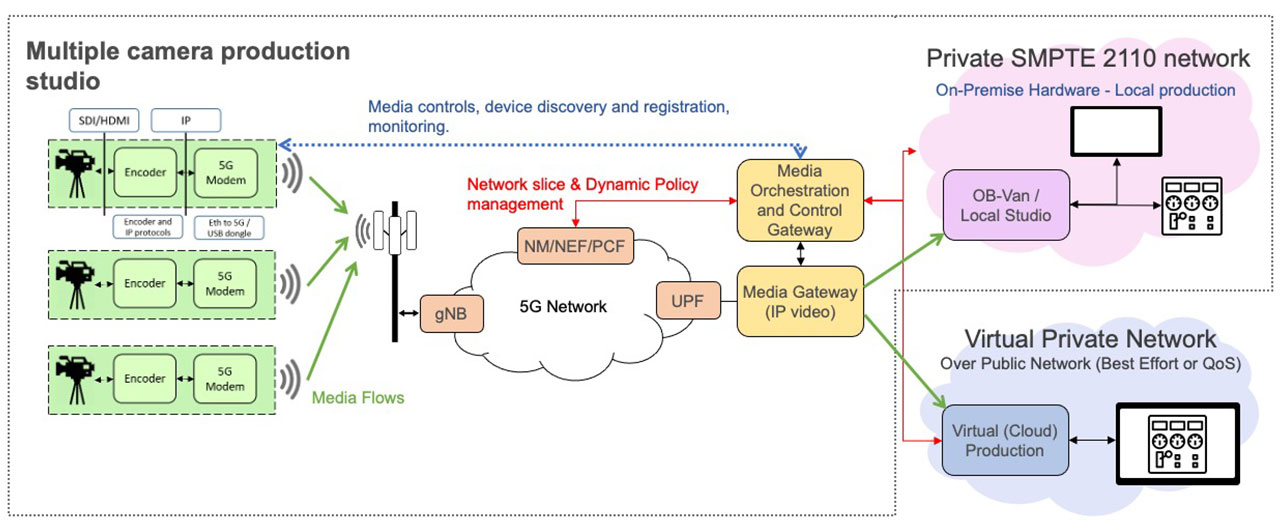
One year after the inception of 5G-RECORDS, the consortium has now entered the second phase of testing for its ‘multiple camera wireless studio’ use-case.
5G has the potential to greatly facilitate, and possibly even revolutionize, media content production. Think of news coverage, or the dozens of wireless cameras and microphones used at large scale live events, or live productions covering large geographical footprints. But much depends on the exact features of the not yet fully defined mobile standard and the ways in which the technology is made available to potential users. The EBU is working with partners to ensure that the full potential of 5G can be exploited for professional media applications.
The 5G-RECORDS consortium specifically investigates the use of ‘Non-Public Networks’. The project is looking at the use of NPNs for three scenarios: live audio production, multi-cam wireless studio production, and live immersive content production. 5G-RECORDS consortium came together in 2020 and now involves 19 partners, among them 7 high-tech companies, 4 broadcasters, 2 universities, 2 infrastructure providers, 2 media technology vendors, a research centre, as well as a mobile network operator.
“We lead the technical work for the EU-funded 5G-RECORDS project”, says Hans Hoffmann Head of the Media Fundamentals and Production Technology at the EBU. “This way, the EBU can ensure that emerging production tools will be well matched to the needs of public media.”
Defining what matters
The use-cases that 5G-RECORDS looks at involve video, audio and data processing with stringent requirements in terms of quality, data rate, latency, reliability and synchronization between devices.
Sometimes, it’s all about the right balance: conventional HD/UHD fibre-based studio setups use 3/12 Gbit/s per camera with uncompressed signals. A 5G network cannot provide the uplink capacity necessary to transmit uncompressed signals, so some compression is necessary, in a carefully trade-off between quality, bit rate and latency.
The multiple camera wireless studio use-case (UC2), in which all participating broadcasters (BBC, RAI, TV2) are involved, touches all of these aspects and requires custom hardware for testing. The main scenario (see Fig.2) is about equipping the cameras with an external codec and modem that feed the video signal into the 5G network, and a media gateway on the other end that maps the 5G protocols to the ST 2110 Live IP standard. For the testing, Ericsson will provide the 5G network infrastructure, Image Matters is the codec board, Fivecomm the modem, and Bisect the media gateway.

And of course, a production team using this setup not only wants to be able to connect to the cameras but also to control them remotely. This is enabled through services provided in the media orchestration and control layer, the development of which is being led by the BBC together with EBU, Ericsson, Bisect, RAI, TV2 and UPV.
A first round of tests was recently performed at the Ericsson lab in Aachen, with Ericsson and TV2 testing the end-to-end connectivity and EBU looking at the accuracy of the system’s PTP timecode signal. The second round of tests will focus on the media gateway and media orchestration and control layer and is planned for September 2021.
The 5G-RECORDS consortium will also test related scenarios and elements, in particular:
- A single unit multi-camera remote production contribution using 5G SA (Standalone) cellular bonding and SMPTE ST-2110 video output. These tests will be led by LiveU and RAI.
- The integration of MCR solutions for routing or for virtual productions in the cloud. These tests will be Led by Redbee Media.
All these tests are laying the groundwork for the next challenge: the project’s live production trials in 2022. Detailed information about the partners and the project as whole is available on the website: https://www.5g-records.eu/
